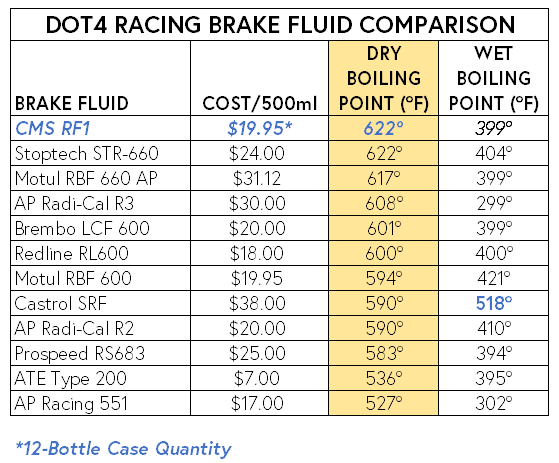CMS RF1 DOT4 Racing Brake Fluid
HIGH BOILING POINT WITHOUT THE HIGH PRICE
RF1 Racing Brake Fluid from CMS Performance is a fully-synthetic DOT4 brake fluid formulated to provide extraordinary performance under the most demanding high-temperature racing and track-day conditions. With a dry boiling point of 328º C (622º F), RF1 exceeds all DOT3 & DOT4 requirements and is compatible with all DOT 3, 4, and 5.1 fluids. (Not compatible with DOT5 or mineral-based brake fluids.)
On the race track, brake systems operate at very high sustained temperatures, and there is perhaps no single safety system more important in racing than your brakes. No single part of that system is more critical than brake fluid. At CMS Performance, we got tired of (and a little nervous) using "racing" brake fluid at the race track that didn't live up to its claimed performance when things got hot.
So we did something about it. Manufactured in partnership with Orthene, the brake fluid supplier to many teams in Formula 1, WEC, and other professional series, RF1 Racing Brake Fluid was formulated to maintain consistent viscosity, lubricity, and compressibility at the extreme system temperatures and line pressures found in racing and track days.
The bottom line is this: you can spend more on brake fluid, but you can't buy higher-performance than RF1 Racing Brake Fluid.
RF1 RACING BRAKE FLUID DETAILS
- Typical dry boiling point: 328º C (622º F)
- Typical wet boiling point: 204º C (399º F)
- Exceeds DOT3 & DOT4 standards
- Bottle size: 500 ml (16.9 fl oz)
Click Here for Product MSDS Sheet
A WORD ABOUT FLUSHING RACING BRAKE FLUID
All brake fluid degrades over time (not mileage), attracting water as it ages, which, at high brake temperatures, can lead to fluid boil and brake fade or failure. That's why the "wet" (aged) boiling point of any brake fluid is substantially lower than the "dry" (new) boiling point.
To maintain maximum braking performance, Competition Motorsport strongly suggests replacing your brake fluid before every track event, but at least every three months if you're consistently racing and/or driving at track days. It's cheap insurance against learning about brake fade the hard way!














